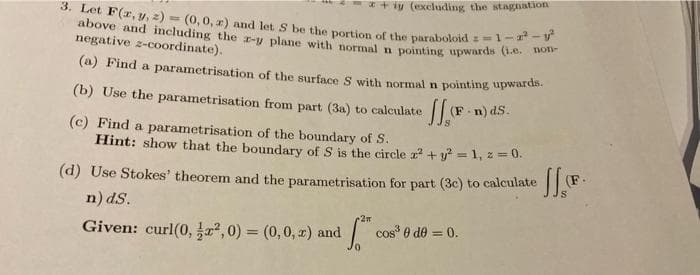*+iy (excluding the stagnation 3. Let F(x, y, z) = (0, 0, a) and let S be the portion of the paraboloid :=1-2²-²2² negative 2-coordinate). (.e. non- (a) Find a parametrisation of the surface 5 with normal n pointing upwards. (b) Use the parametrisation from part (3a) to calculate (F-n) ds. (c) Find a parametrisation of the boundary of S. Hint: show that the boundary of S is the circle x² + y² = 1, z = 0. (d) Use Stokes' theorem and the parametrisation for part (3c) to calculate n) ds. 2m cos³0 de = 0. Given: curl(0,²,0) = (0,0,r) and JL.F.
*+iy (excluding the stagnation 3. Let F(x, y, z) = (0, 0, a) and let S be the portion of the paraboloid :=1-2²-²2² negative 2-coordinate). (.e. non- (a) Find a parametrisation of the surface 5 with normal n pointing upwards. (b) Use the parametrisation from part (3a) to calculate (F-n) ds. (c) Find a parametrisation of the boundary of S. Hint: show that the boundary of S is the circle x² + y² = 1, z = 0. (d) Use Stokes' theorem and the parametrisation for part (3c) to calculate n) ds. 2m cos³0 de = 0. Given: curl(0,²,0) = (0,0,r) and JL.F.
Elementary Geometry For College Students, 7e
7th Edition
ISBN:9781337614085
Author:Alexander, Daniel C.; Koeberlein, Geralyn M.
Publisher:Alexander, Daniel C.; Koeberlein, Geralyn M.
Chapter10: Analytic Geometry
Section10.6: The Three-dimensional Coordinate System
Problem 41E: Does the sphere x2+y2+z2=100 have symmetry with respect to the a x-axis? b xy-plane?
Related questions
Question

Transcribed Image Text:* + iy (excluding the stagnation
3. Let F(r, y, 2) = (0,0, z) and let S be the portion of the paraboloid s=1-
above and including the r-y plane with normal n pointing upwards
negative z-coordinate).
(a) Find a parametrisation of the surface S with normal n pointing upwardh
(b) Use the parametrisation from part (3a) to calculate
(F n) dS.
(c) Find a parametrisation of the boundary of S.
Hint: show that the boundary of S is the circle z + y = 1, z = 0.
(d) Use Stokes' theorem and the parametrisation for part (3c) to calculate
n) dS.
cos 0 de = 0.
Given: curl(0, , 0) = (0,0, 2) and
Expert Solution
This question has been solved!
Explore an expertly crafted, step-by-step solution for a thorough understanding of key concepts.
Step by step
Solved in 3 steps with 2 images

Recommended textbooks for you

Elementary Geometry For College Students, 7e
Geometry
ISBN:
9781337614085
Author:
Alexander, Daniel C.; Koeberlein, Geralyn M.
Publisher:
Cengage,

Elementary Geometry For College Students, 7e
Geometry
ISBN:
9781337614085
Author:
Alexander, Daniel C.; Koeberlein, Geralyn M.
Publisher:
Cengage,